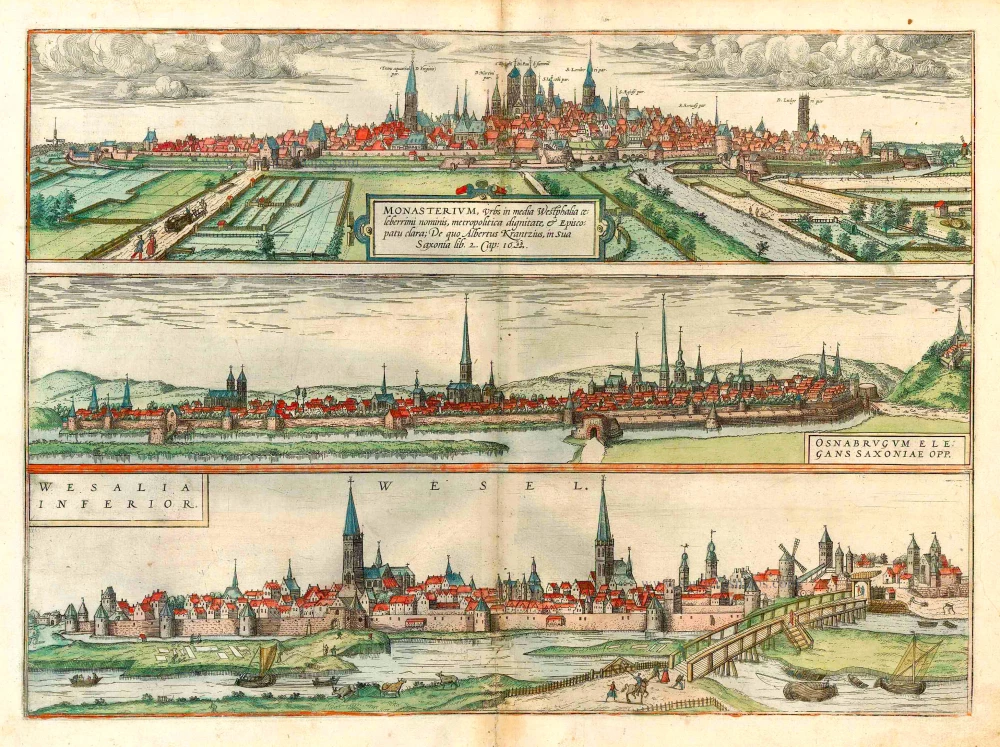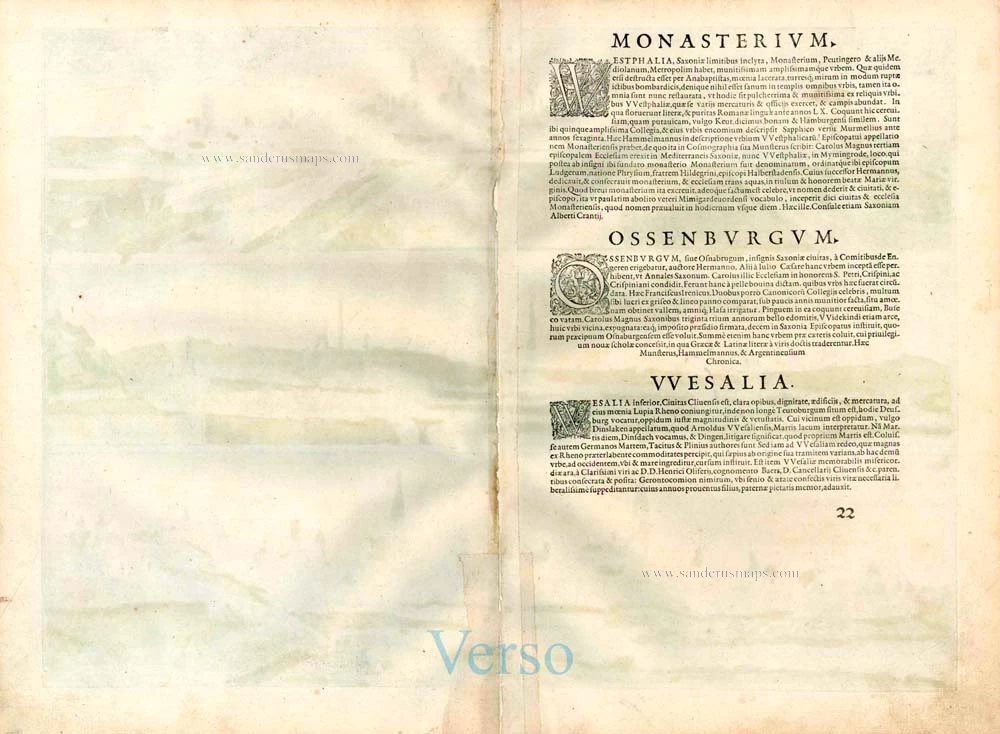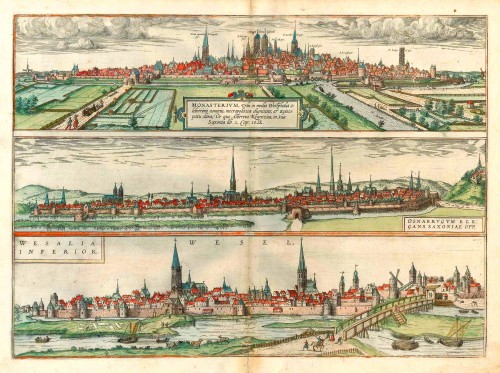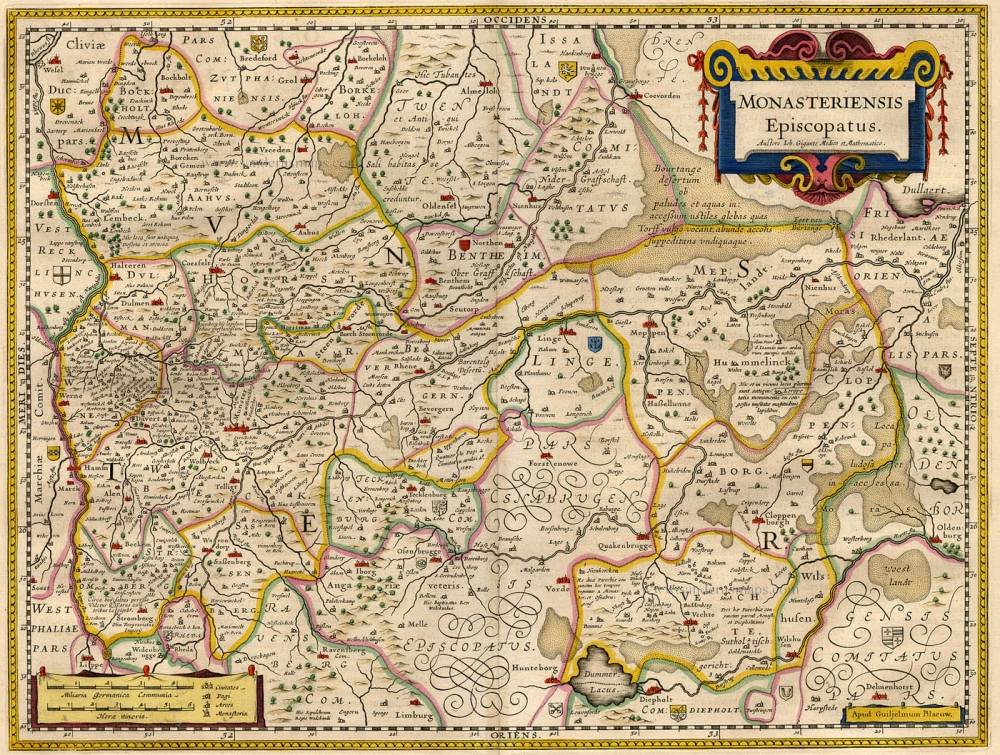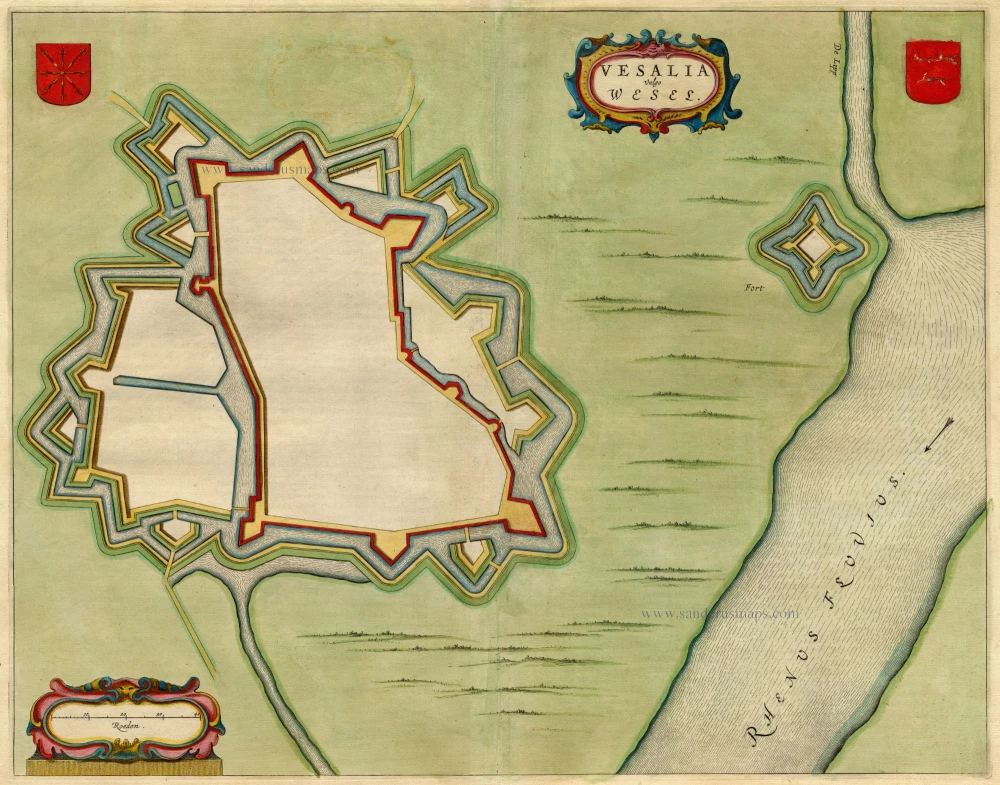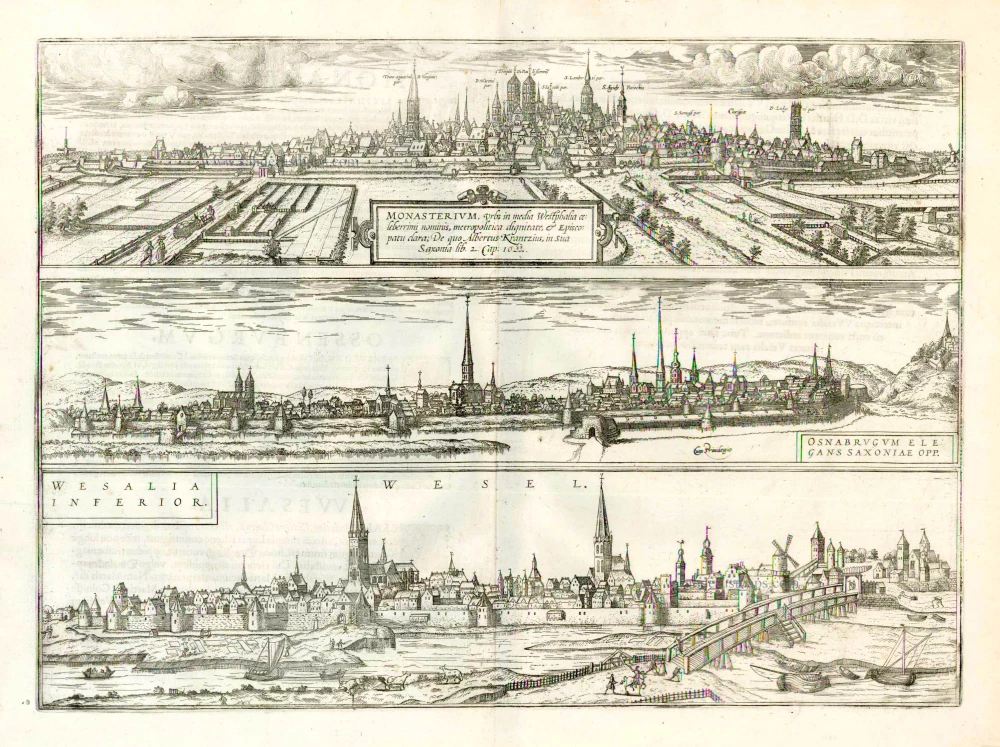Munster - Osnabruck - Wesel by Braun & Hogenberg 1582
MÜNSTER
TRANSLATION OF CARTOUCHE TEXT: Münster, a city with a famous name situated in the middle of Westphalia, is distinguished as a capital and a cathedral city; Albert Krantz mentions it in his Saxonia, 1520.
COMMENTARY BY BRAUN: "Münster is a large and fortified city, capital of the province of Westphalia [...]. Although the Anabaptists destroyed this city, the walls torn down, the gates damaged by constant bombardment and nothing left unscathed in the churches either, the city was nevertheless rebuilt and is now considered the most beautiful and strongest of all the other cities of Westphalia; the inhabitants live from trade and craft. [...] A good beer is also brewed here, which the people of Münster call Keute and is very similar to the Hamburg beer."
The engraving shows a view of Münster from the southwest and devotes much attention to the surrounding countryside with its windmills, neat fields, and the dramatic clouds overhead. The well-fortified city is hallmarked by its churches and steeples, including the Überwasser church on the left, the soaring cathedral of St Paul's in the centre, St Lambert's church on the right and St Ludgerius's church on the far right. In the foreground, Münster's fortifications include defensive works protecting the point at which the River Aa flows into the city. Münster was granted its charter in 1170 and joined the Hanseatic League in the mid-1300s. The city's economic prosperity during this period is reflected even today in its primary market square, the Prinzipal-Markt. The Münster Rebellion of 1534/35, when Protestant Anabaptists temporarily took over the city's running, was particularly significant. In June 1535, after a lengthy siege, the city was starved out and stormed by Bishop Franz von Waldeck. The Anabaptists were executed, and - as a deterrent - their corpses were displayed in iron baskets hung from St Lambert's steeple.
OSNABRÜCK
COMMENTARY BY BRAUN: "Emperor Charlemagne built a church here in honour of SS Peter and Crispin. Osnabrück has two monasteries, conducts much trade, does a good business in grey cloth and linen, and lies in an attractive valley on the River Hase. Good beer is made here, called Büse. [...] Since Emperor Charlemagne particularly liked this city, he also granted it privileges: he ordered the building of a school in which Greek and Latin were taught."
Like those preceding and following it, the engraving of Osnabrück is seen from the relatively low perspective of someone approaching the city, in this case from Klushügel Hill. The many churches dominate the view: St Peter's cathedral on the left, whose two massive towers still hallmark the skyline today. In the centre, the late Gothic three-aisled church of St Catherine, with its 103-m-high spire, is the tallest medieval building in Lower Saxony. Osnabrück developed after AD 780 around the see created by Charlemagne. The city's name probably derives from the Lower Saxon words Ossen and Brügge, meaning "ox bridge". The Peace of Westphalia was concluded in 1648 in the late Gothic town hall.
WESEL
COMMENTARY BY BRAUN: "The Cleves city of Lower Wesel, where the Lippe flows into the Rhine, is graced with wealth and renown, numerous buildings and flourishing commerce. [...] The city benefits greatly from the Rhine flowing past, which often alters its usual course and moves westward towards the sea and away from the city. [...] As a particular token of the charity of the highly esteemed and learned Heinrich Olichschleger the Elder, a hospital was built for elderly men in need, to whom he assures an annual living through his benevolence."
The view shows the city of Wesel from the south, where the Lippe joins the Rhine. Recognisable on the left is St Willibrod's cathedral, only recently expanded into a five-aisled church, and on the right, the filial church of SS Nicholas and Antony, known as the Mathenakirche, after its location in the Mathena district. The boat with the bulbous hull in the foreground is based on Netherlandish ocean-going vessels and was suitable for sailing and towing (i.e. by horses or people towing the boat upstream). The home for the elderly, as mentioned by Braun and endowed by Heinrich Olichschleger in 1524, was one of the private foundations that typically housed six to twelve elderly people; in this particular case, the hospital accommodated twelve men and six women in separate buildings. (Taschen)
Monasterium, Urbs in Media Westphalia Celeberrimi Nominis ... [on sheet with] Osnabrugum Elegans Saxoniae Opp. [and] Wesalia Inferior.
Item Number: 25492 Authenticity Guarantee
Category: Antique maps > Europe > Germany - Cities
Three bird's-eye views by Braun and Hogenberg: Münster, Osnabrück and Wesel.
Title: Monasterium, Urbs in Media Westphalia Celeberrimi Nominis ... [on sheet with] Osnabrugum Elegans Saxoniae Opp. [and] Wesalia Inferior.
Date of the first edition: 1572.
Date of this map: 1582.
Copper engraving, printed on paper.
Size (not including margins): 340 x 465mm (13.39 x 18.31 inches).
Verso: Latin text.
Condition: Original coloured., excellent.
Condition Rating: A+.
From: Civitates Orbis Terrarum, Liber Primus. Köln, Gottfried von Kempen, 1582. (Van der Krogt 4, 41:1.1(1582))
MÜNSTER
TRANSLATION OF CARTOUCHE TEXT: Münster, a city with a famous name situated in the middle of Westphalia, is distinguished as a capital and a cathedral city; Albert Krantz mentions it in his Saxonia, 1520.
COMMENTARY BY BRAUN: "Münster is a large and fortified city, capital of the province of Westphalia [...]. Although the Anabaptists destroyed this city, the walls torn down, the gates damaged by constant bombardment and nothing left unscathed in the churches either, the city was nevertheless rebuilt and is now considered the most beautiful and strongest of all the other cities of Westphalia; the inhabitants live from trade and craft. [...] A good beer is also brewed here, which the people of Münster call Keute and is very similar to the Hamburg beer."
The engraving shows a view of Münster from the southwest and devotes much attention to the surrounding countryside with its windmills, neat fields, and the dramatic clouds overhead. The well-fortified city is hallmarked by its churches and steeples, including the Überwasser church on the left, the soaring cathedral of St Paul's in the centre, St Lambert's church on the right and St Ludgerius's church on the far right. In the foreground, Münster's fortifications include defensive works protecting the point at which the River Aa flows into the city. Münster was granted its charter in 1170 and joined the Hanseatic League in the mid-1300s. The city's economic prosperity during this period is reflected even today in its primary market square, the Prinzipal-Markt. The Münster Rebellion of 1534/35, when Protestant Anabaptists temporarily took over the city's running, was particularly significant. In June 1535, after a lengthy siege, the city was starved out and stormed by Bishop Franz von Waldeck. The Anabaptists were executed, and - as a deterrent - their corpses were displayed in iron baskets hung from St Lambert's steeple.
OSNABRÜCK
COMMENTARY BY BRAUN: "Emperor Charlemagne built a church here in honour of SS Peter and Crispin. Osnabrück has two monasteries, conducts much trade, does a good business in grey cloth and linen, and lies in an attractive valley on the River Hase. Good beer is made here, called Büse. [...] Since Emperor Charlemagne particularly liked this city, he also granted it privileges: he ordered the building of a school in which Greek and Latin were taught."
Like those preceding and following it, the engraving of Osnabrück is seen from the relatively low perspective of someone approaching the city, in this case from Klushügel Hill. The many churches dominate the view: St Peter's cathedral on the left, whose two massive towers still hallmark the skyline today. In the centre, the late Gothic three-aisled church of St Catherine, with its 103-m-high spire, is the tallest medieval building in Lower Saxony. Osnabrück developed after AD 780 around the see created by Charlemagne. The city's name probably derives from the Lower Saxon words Ossen and Brügge, meaning "ox bridge". The Peace of Westphalia was concluded in 1648 in the late Gothic town hall.
WESEL
COMMENTARY BY BRAUN: "The Cleves city of Lower Wesel, where the Lippe flows into the Rhine, is graced with wealth and renown, numerous buildings and flourishing commerce. [...] The city benefits greatly from the Rhine flowing past, which often alters its usual course and moves westward towards the sea and away from the city. [...] As a particular token of the charity of the highly esteemed and learned Heinrich Olichschleger the Elder, a hospital was built for elderly men in need, to whom he assures an annual living through his benevolence."
The view shows the city of Wesel from the south, where the Lippe joins the Rhine. Recognisable on the left is St Willibrod's cathedral, only recently expanded into a five-aisled church, and on the right, the filial church of SS Nicholas and Antony, known as the Mathenakirche, after its location in the Mathena district. The boat with the bulbous hull in the foreground is based on Netherlandish ocean-going vessels and was suitable for sailing and towing (i.e. by horses or people towing the boat upstream). The home for the elderly, as mentioned by Braun and endowed by Heinrich Olichschleger in 1524, was one of the private foundations that typically housed six to twelve elderly people; in this particular case, the hospital accommodated twelve men and six women in separate buildings. (Taschen)

